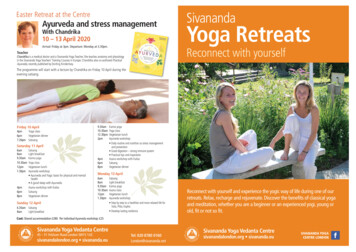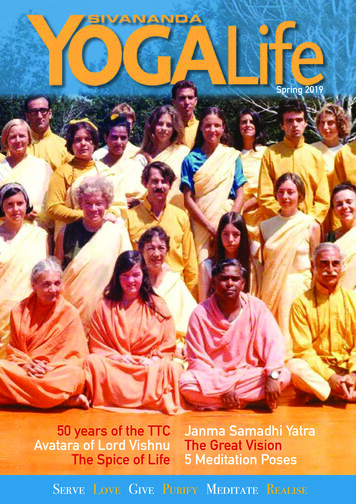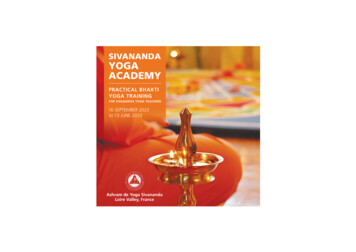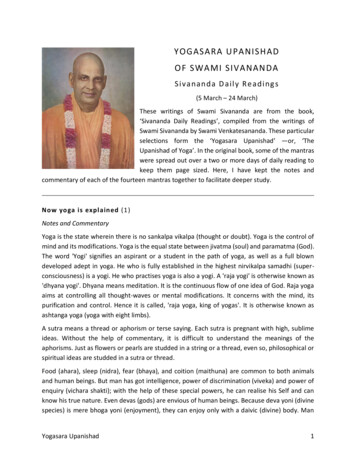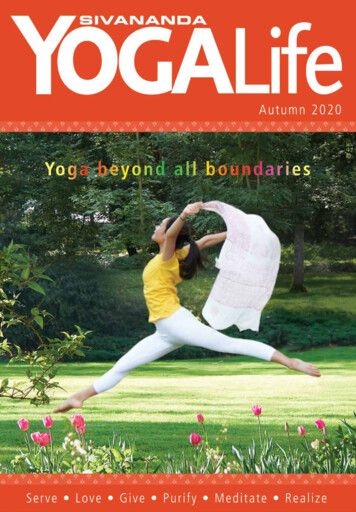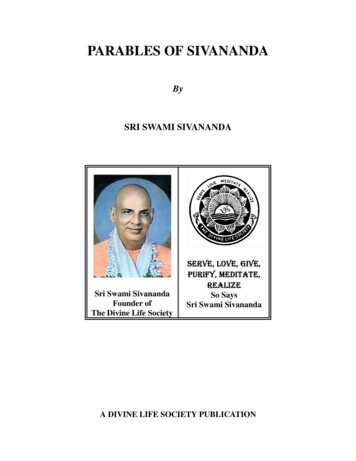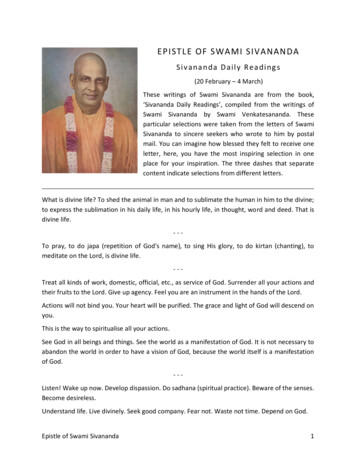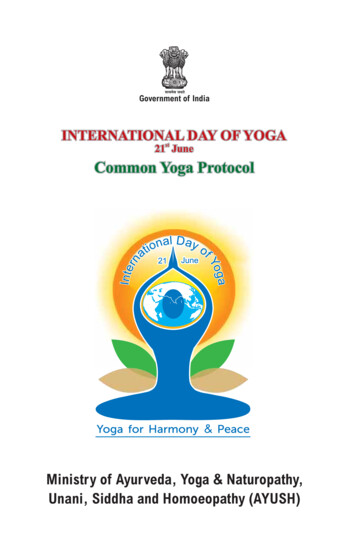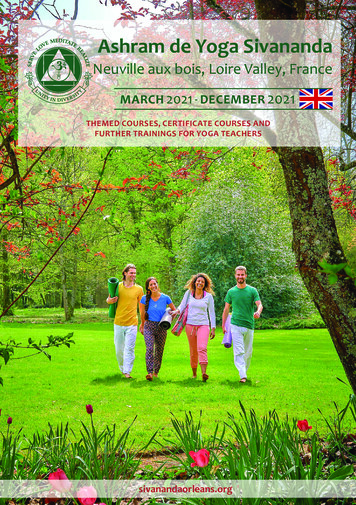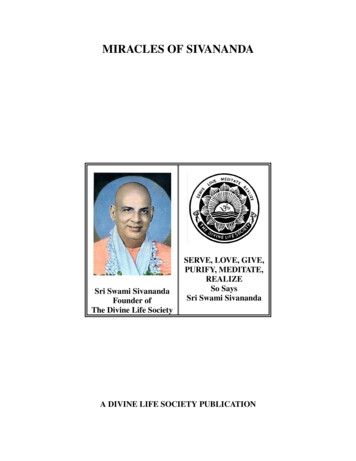
Transcription
SIVANANDA'S INTEGRAL YOGABySiva-Pada-RenuSWAMI VENKATESANANDA6(59( /29( *,9( 385,) 0(',7 7( 5( /, (So SaysSri Swami SivanandaSri Swami VenkatesanandaA DIVINE LIFE SOCIETY PUBLICATION
Seventh Edition: 1981(2000 Copies)World Wide Web (WWW) Edition : 1998WWW site: http://www.rsl.ukans.edu/ pkanagar/divine/This WWW reprint is for free distribution The Divine Life Trust SocietyPublished ByTHE DIVINE LIFE SOCIETYP.O. SHIVANANDANAGAR—249 192Distt. Tehri-Garhwal, Uttar Pradesh,Himalayas, India.
PRAYERFUL DEDICATION TO BHAGAVAN SIVANANDALord!Condescend to accept this humble flower, fragrant with the aroma of thine own divineglory, immeasurable and infinite. Hundreds of savants and scholars might write hundreds of tomeson your glory, yet it would still transcend them all.In accordance with thine ancient promise:yada yada hi dharmasya glanir bhavati bharataabhyutthanamadharmasya tadatmanam srijamyahamparitranaya sadhoonam vinasaya cha dushkritamdharmasamsthapanarthaya sambhavami yuge yuge(Gita IV–7, 8)You, the Supreme Being, the all-pervading Sat-chidaranda-Para-Brahman, have taken thishuman garb and come into this world to re-establish Dharma (righteousness). The wonderfultransformation you have brought about in the lives of millions all over the world is positive proof ofyour Divinity.I am honestly amazed at my own audacity in trying to bring this Supreme God, BhagavanSivananda, to the level of a human being (though Sage Valmiki had done so while narrating thestory to Lord Rama) and to describe the Yoga of the Yogeshwareshwara, the goal of all Yogins.Lord! I cling to Thy lotus-feet and beg for Thy merciful pardon.If, however, these pages do inspire some others to take up Thy cross and follow Thee, myGurudev, I shall have been amply justified in this misadventure. What is Sivananda’s Cross ?It is:Meditate Love– –Serve RealiseThis is what has been dealt with in this humble attempt at the presentation of ust of Sivananda’s Feet),Swami Venkatesananda.iii
CONTENTSPRAYERFUL DEDICATION TO BHAGAVAN SIVANANDA . . . . . . . . . . . . . . . . iiiA LITTLE OF ALL . . . . . . . . . . . . . . . . . . . . . . . . . . . . . . . . . . . . . . . . 1Yoga Asana . . . . . . . . . . . . . . . . . . . . . . . . . . . . . . . . . . . . . . . . . . 2Diet . . . . . . . . . . . . . . . . . . . . . . . . . . . . . . . . . . . . . . . . . . . . . . 4Pranayama. . . . . . . . . . . . . . . . . . . . . . . . . . . . . . . . . . . . . . . . . . . 4Health Redefined . . . . . . . . . . . . . . . . . . . . . . . . . . . . . . . . . . . . . . . 5THE SECRET OF SELFLESS SERVICE . . . . . . . . . . . . . . . . . . . . . . . . . . . . 9Compulsive Sharing . . . . . . . . . . . . . . . . . . . . . . . . . . . . . . . . . . . . . 11Spontaneous Overwhelming Generosity . . . . . . . . . . . . . . . . . . . . . . . . . . 13Trying Situations . . . . . . . . . . . . . . . . . . . . . . . . . . . . . . . . . . . . . . 14The Razor’s Edge . . . . . . . . . . . . . . . . . . . . . . . . . . . . . . . . . . . . . . 16Fearlessness . . . . . . . . . . . . . . . . . . . . . . . . . . . . . . . . . . . . . . . . . 18The Refuge Of Destitutes . . . . . . . . . . . . . . . . . . . . . . . . . . . . . . . . . . 20The Spirit . . . . . . . . . . . . . . . . . . . . . . . . . . . . . . . . . . . . . . . . . . 21See God In All . . . . . . . . . . . . . . . . . . . . . . . . . . . . . . . . . . . . . . . . 21Training Of Disciples . . . . . . . . . . . . . . . . . . . . . . . . . . . . . . . . . . . . 23SEE GOD IN ALL . . . . . . . . .Mantra Repetition . . . . . . .Religious Freedom. . . . . . .True Catholic . . . . . . . . .Worship Of God In An Image .Worship Of The Omnipresent .Vibhuti Yoga . . . . . . . . .Devotional Singing . . . . . .Satsanga . . . . . . . . . . . .Prayer . . . . . . . . . . . . .Faith In God . . . . . . . . . .3131353739404144475052VIRTUE AND VISION . . . . . . . . . . .Yama-Niyama . . . . . . . . . . . . . .Renunciation . . . . . . . . . . . . . . .Pratyahara (Abstraction of the Senses) .Meditation . . . . . . . . . . . . . . . .Siddhis (psychic powers) or (perfection)The Mighty Intellect Of Gurudev . . . .53555870707375SELF-KNOWLEDGE . . . . . . . . . . . . . . . . . . . . . . . . . . . . . . . . . . . . . . 77Gurudev’s Preceptor . . . . . . . . . . . . . . . . . . . . . . . . . . . . . . . . . . . . . 80Sravana, Manana, Nididhyasana . . . . . . . . . . . . . . . . . . . . . . . . . . . . . . 81CONCLUSION. . . . . . . . . . . . . . . . . . . . . . . . . . . . . . . . . . . . . . . . . . 83iv
CHAPTER ONEA LITTLE OF ALLIn the history of the world there have been sages, saints and prophets who have practisedand preached one or the other modes of approaching the goal, which is self-realisation. It wasGurudev1, the prophet of integral yoga, who insisted “It is not enough to practise any one kind ofspiritual discipline, however well you may strive to do so. Every aspirant should incorporate in hisspiritual programme all the items of all the yogas or modes of approaching God.”Gurudev had no doctrine of his own. He re-delivered the same message that has from thebeginning of time been given to us by the divine. His were the lips of God. He was one with God.Yet, if we can audaciously read a doctrine into his teaching, his own unique approach to the scienceof yoga can be called “The Yoga of a Little” or the yoga of synthesis. He warned us that only theharmonious development of the entire being could take us easily to the goal. A weak spot anywherein the structure would ruin the whole.He composed a rather simple but beautiful little song, which he himself sang in theMahamantra tune at every meeting he addressed, especially during his All-India-Ceylon Tour in1950.hare rama, hare rama, rama rama, hare harehare krishna, hare krishna, krishna krishna, hare hareEat a little, drink a little;talk a little, sleep a little.Mix a little, move a little;serve a little, give a little;Work a little, rest a little;study a little, worship a little.Do asana a little, pranayama a little;reflect a little, meditate a little,Do japa a little, do kirtan a little,write mantra a little, have satsanga a little.Do all these, little, little. You will have time for all.Was the Master against doing more of these wonderful things–like japa, asanas, ormeditation? You ask, “Why only a little, why not much?” Then, we go on to interpret this to mean,“Do at least a little . .” But he really meant just this, “Do a little of each, don’t specialise.” That wasthe message–because the thing that clamours for specialisation is the ego, for the specialist isadmired by the crowd. Specialisation fattens one’s ego, weakens the spirit of tolerance andunderstanding, and creates contempt and hatred.1In this work, Gurudev , Swamiji and the Master" refer to Swami Sivananda.1
SIVANANDA’S INTEGRAL YOGAYoga is harmony. A beautiful, symmetrical and integral development of the total being,which means exercising every aspect of your personality every day. Otherwise there is animbalance of personality, which is no yoga. In Gurudev’s way therefore you cannot spend too muchtime per day on any one practice, whatever it may be. A true follower of Swami Sivananda can onlydo a little of all. Thus there is harmonious development, health (wholeness) of body, mind andspirit.Gurudev, while still a senior student at the medical college, was very eager that peopleshould know the art of healthy living rather than the technique of healing. The need for curativetreatment arises only when you have been foolish enough to fall ill. Why not prevent it? Soon afterleaving college, he started a magazine called “Ambrosia” and in that magazine he published everylittle hint, secret or non-secret, that he could unearth. People must be educated on how to preventthemselves from falling ill, not so much on how to find a cure. Curing is only emergency treatment.Throughout his life he was passionately devoted to making knowledge and service availableand free to as many people as possible. These two were unique passions of the Master–health andservice. He had no use at all for secrets (“I have this special exclusive remedy, come to ME.”) If hecame upon a secret theory, it had to be published the next morning. Once when someone in theashram wished to prepare a correspondence course from Swamiji’s writings, publishing one lessona month and making money from the project, Swamiji agreed. But once it was done, Swamijiimmediately put the lessons back into book form and had them published for immediatedistribution, mostly free.He was a professional doctor, who sought by every possible means to help you not to go to adoctor. Even so the practice of yoga asanas, which he enthusiastically commenced with the aid ofsome books while in Malaya, became part of this whole approach to health. His book on hatha yogacontains the fundamental essence of the basic ancient texts. The importance that hatha yoga playedin the total scheme of his teachings was how to keep yourself healthy, really healthy.How to be healthy? What does ‘health’ really mean? Health by definition meansWHOLENESS. You cannot have physical health at the expense of mental health. There is no suchthing as physical health. Health being wholeness cannot be divided into physical, mental andspiritual. A harmonious development of both body and mind was Gurudev’s speciality. Frequentlyin his writings on yoga physical culture, he comes back to mental health, spiritual well-being. If themind is completely, disorganised and neurotic, the body cannot be healthy, however many asanasyou practise, for however long, however perfectly.Yoga AsanaGurudev did not neglect his yoga asana practice even for a day. He himself only startedpractising them when he was nearly thirty. He insisted, “It is never too late to start, and there is nocondition under which the asanas should be given up; even in disease the asanas should only bemodified to suit the condition of the body.” At the best of times he did the sirasasana (headstand) forfive or ten minutes. He also did sarvangasana (shoulder stand), and to these two he added a fewmore; a little forward bending, mahamudra, paschimottanasana and halasana.2
A LITTLE OF ALLSimilarly, some mild physical exercises formed part of Gurudev’s daily routine. “Sitting onyour bed, just after you wake up you can finish these exercises in five minutes” he used to say.Sitting cross legged, he bent forward, then leaned backward, supporting the trunk with the palmsplanted on the bed, then twisted the trunk left and right. Catching hold of the toes he would roll andswing backward, making a seesaw with the back. Getting out of bed he would stand and leanforward against a wall and do some mild trunk twisting exercises. Anyone can do these, they are soeasy and the benefits are incalculable.What Gurudev loved he enthusiastically encouraged others to do. He was by no means ayoga asana specialist, yet if he talked to you about it his enthusiasm was so infectious that youwould feel, “Oh I must start right away.” While still in Malaya, Gurudev’s cook, Sri NarasimhaIyer, was also swept up by the doctor’s enthusiasm and eagerly joined him in the yoga asanas (Manyyears later he became his Sannyasin-disciple). Swami Sivananda often taught yoga postures toyoung men wherever he happened to be, on the platform of a railway station, or on the pavement.He used to call it ‘aggressive service.’ “Don’t wait till someone comes to you, pays yoursubscription and joins your class. Teach him here and now, wherever you are.” Gurudev was notfond of theories which say: ‘This is the perfection in this asana.’ His teaching was: “Do what youcan now today, to the best of your ability, sincerely, seriously, honestly–this is perfection.” If youreach out to that today and if you are regular, it is possible you might develop a little more, and alittle more. But do NOT look at somebody else, with envy or to copy.This was another unique feature of Swami Sivananda–he could really genuinely andsincerely appreciate someone who did something better than himself. There was not even a trace ofjealousy in him. It was remarkable. For instance if some great hatha yogi visited the ashram (andmany did) and this man performed some fantastic feat, Swamiji would talk about this man for yearsto come, with no reservations: “He is a yogi! He must be unique in the world!” He would openlyglorify his own disciples too.The Master was also fond of gymnastics and sports, and he loved walking. Even as a schoolstudent he was so efficient at gymnastics that his instructor often made him teach the class. In theearly years in the ashram life, he used to run around the bhajan (prayer) hall. Can you imagine thislarge man, this great world renowned Swami Sivananda, sage of the Himalayas, the Great Yogi ofIndia, etc. etc. tying up his dhoti (cloth around his waist) and jogging around a public hall? He wasnot self-conscious at all. With an old tennis racket and a ball, he also used to play with himselfagainst the wall.In summer Gurudev loved to swim. He had a bald head, and he would sit on the Gangesbank, naked except for a loin cloth, and rub his body nicely with oil. He had his own health hints andsunbathing ideas. Not only must your skin be exposed to the sun, but your tongue and teeth also. Hewould sit there, right in the open, smiling, and grinning at the sun, sticking his tongue out, bathingthem in the sunlight.Health is a vital pre-requisite for spiritual practice, and even for enjoying life or for runningyour business efficiently, but health must include the body, mind and soul. There must be emotionalbalance, and rest and diet are also important.3
SIVANANDA’S INTEGRAL YOGADiet“This is right and that is wrong.” I have never heard him lay down such categoricalimperatives. You find them in his books–but there he is only relaying traditional teaching. Asregards diet he used to say: “Take sattvic food”, food that does not excite you, throw you offbalance, or disturb your equilibrium. You have to understand the principle, understand the teaching,and then see what suits you at the particular stage you are at. The Master himself took very hot,spicy, pungent food–but that was alright for him. You cannot copy him. You must discover whatsattvic food means to you; as Swamiji also used to say, “Use your common-sense.” That seems tobe difficult!With food, as with asanas, Gurudev emphasised more the psychic effects: psychic in thesense of the effect on the nervous system, the mind, and the inner psychic principle, rather thanmere physiological reaction. So one has to put all this together and imbibe the spirit–the truth beingneither “this” nor “that” but something in between.PranayamaGurudev was a great believer and exponent of pranayama. He loved it. His ideal beingintegral yoga, both exercise of the body and control of breath (and thereby the life-force) had theirplace. Pranayama floods the system with peace and bliss. It is an astonishing fact that SwamiSivananda devoted several hours of his extremely busy day to his practice.He was extremely fond of what he called ‘Sukha Purvaka’ or the ‘Simple Pranayama’ veryeasy and comfortable. In the winter he also did bhastrika: it was beautiful to watch him do this. Hedid not insist that you should hold your breath as long as possible (as the orthodox texts seem toimply) but as long as comfortable. Do you immediately notice the problem? “Inhale as long ascomfortable. Hold as long as comfortable. Exhale as long as comfortable.” Two words are equallyimportant–’long’ and ‘comfortable’. It is not as ‘short’ as comfortable–then just anything will do.No. It must be prolonged. This made Gurudev’s yoga a bit more difficult than the traditionalapproach, where a definite rule or measure is laid down to guide you.Gurudev’s pranayama involves vigilance. There must be watchfulness, seriousness,sincerity. You must set out to find your limit, but not to exceed it. There must be no violence, noforce, and no tension at all. In this way inner harmony is promoted. Yoga has to be practisedseriously but without violence, without the sprit of competition. It is a beautiful thing. This isSivananda’s yoga.Invariably he woke up before 3.00 a.m. which was well before the time he asked all thespiritual aspirants to rise. At this time he used to devote over an hour to pranayama alone, andduring an extremely busy day, he would spend at least another three hours in this practice, in severalsessions, whenever he found the time. In the last year of his life, when he was not able to do verymuch in the way of yoga asanas, he said, “At every opportunity I do pranayama; even lying down Ido pranayama and especially at night if I can’t (don’t) sleep.” If he could, he would prop himself upon some pillows and do it. This was his advice to almost everyone who met him, “If you can’t do theyoga asanas properly, just do the best that you can, but practise a lot of pranayama.” He realised that4
A LITTLE OF ALLpranayama, not merely breathing exercises, has a direct effect on the nervous system and on themind. It promotes an inner state of well-being quite different from that we conventionally callhealth.Health RedefinedIf someone hasn’t been to a doctor for the last six months, we think that is health. InGurudev’s case health meant something more. He had diabetes from the age of about thirty-five andlumbago later on and there were other problems. But his face was radiant and shining, his eyessparkling with energy and humour and his every movement full of love and wisdom. His mind, hisbrain, was supremely alert even when the body was weak. Even physically he was extremelyattractive. A robust figure, which if it had belonged to somebody else might have been ugly anduncouth, only added to his charm, added to his majesty. Even the skin was clean, clear, sparkinglywell maintained. His clothes were always spotlessly clean. Even when his body was ill, there wasthat extraordinary glow, that radiance.Once he was down with typhoid, and his body had been so weakened that on one or twooccasions we thought he would pass away. Even then, his eyes were sparkling, his face radiant. Hehad been confined to his room for about three weeks and wanted to see the sun and the Ganges.Slowly we brought him outside and he lay in his favourite chair. If you had looked at him then youwould have said that there was nothing wrong. He was beautiful to look at and he was laughing,joking, and talking to people. After about an hour or so he said, “Alright, let me go back to bed.Wait, I’ll try and get up by myself.” He planted both his feet on the floor and holding the arms of thechair tried to lift himself off . and collapsed . luckily, back into the chair itself. Perhaps you canvisualise the whole scene. You and I would probably have been full of gloom, despair. As he wascollapsing, he started to laugh, “Hm, my legs have lost their strength.” These were his exact words.“My legs”, not “I.”The way he reacted to the many ailments and illnesses that assailed his body can be used as arevolutionary re-definition of the whole concept of health. Health is a state of mind, a state of innerwell-being which enables you to function, to do your work, your allotted task without moaning,grumbling. Health is not the body being declared medically free from illness. Gurudev didn’t mindtaking medicines at all; on the other hand, there was a whole plate full of them after lunch. Hisphilosophy was that if you can take food for the body, you can also take some other thing calledmedicine.Never once through all his illnesses did he moan or groan and when doctors entered hisroom, it was hard for us to convince them that he was sick. Swamiji would ask, “And how is yourhealth?” Likewise when some of the ashram swamis went to see him, he was only concerned abouttheir health, and requested them to look after themselves. Who was the patient, who was the doctor?Lying in bed he used to continue his work marvellously well. He was so tremendously alert andthere was always this state of inner well-being. Sometimes the body functioned 100% sometimesonly 80% or 70% and he was prepared to adjust, prepared to take the body along with him. It lookedas though he graciously allowed some ailments to dwell in his body.5
SIVANANDA’S INTEGRAL YOGAOnce he remarked: “There are two or three things I need. So I’m very careful about them.”He was careful with his eyesight. His voice was also very important to him. He had a ringingbell-metal voice throughout his life and he had his own special exercises for it. He was careful withhis teeth. He said: “If you don’t have proper teeth, you can’t speak well and you can’t eat well.” Hewould adopt any measure that any doctor recommended to keep them clean. Brushing his teeth inthe morning was a big ceremony with him.Thus he protected certain organs. He did not want to be totally and completely dependent onothers. Also, he did not want to lose the instruments with which he served humanity. When later onhe couldn’t move about freely, he used a walking stick. He would give it to somebody else to carry,just in case the need arose. “Keep it with you, if I feel a bit giddy, I’ll take it from you.” The bodyshould not be helped too much as this would weaken it. Later it became a bit more difficult and hehimself used to hold the stick and walk; then, even this was not sufficient and he would holdsomebody’s hand. But the body was nor excused; what had to be done, had to be done. The Master’smind was alert, vigilant, energetic, powerful. He refused to give in to the whims of the body. Whenthe legs would hardly move on account of lumbago and rheumatism, he still insisted: “I’ll come out.I’ll work in the office”.What is that state of mind that is able to overcome physical ailments? What is that state ofmind which sees that though the body is weakening, it is still capable of some functions and those itshould be made to perform cheerfully, whole-heartedly, brilliantly? That is health.At one stage he used to spend about half an hour in my room before he went to the office.The steps next to the room were very steep, and he had to climb them to get to the office. It wasalright for some time when the body was in good health. Then when he had lumbago and could notwalk so easily, he asked for a long stick with the help of which he used to climb those stairs. Whydid he have to go that way? Nobody knew. One day he could no longer even use his stick andliterally bent down and crawled up. He could easily have said ‘I am not well, come to my room.’There was absolutely no despair, no excuses, no moaning at all; there wasn’t evenself-consciousness.That spirit, that state of mind is called health, where even an ageing body cannot dampen orweaken the inner spirit even for a moment. He had this sense of spiritual well-being at all timesthroughout his life.One might attribute some of these to what is popularly known as the kundalini shakti beingawakened. This was never discussed. From within him came an abundance of energy. It filled himand flowed from him constantly.In 1953 the Parliament of Religions was held in the ashram. Hundreds of visitors had comeand for three days the ashram was a hive of activity. The last day’s programme was prolonged bySwami Sivananda and concluded after midnight, and then Swamiji retired. One of the visitors, theSpeaker of the Indian Parliament, wanted to leave very early the next day, and had asked SwamiSivananda, “Can I have your darshan (audience), just to see you before I leave?” and Gurudev hadagreed. The Speaker called on the Master at five o’clock that morning. We could hardly keep oureyes open, but there was not a trace of fatigue on the face of Swami Sivananda. He had hardly gone6
A LITTLE OF ALLto bed two or three hours before and here he was, talking and chatting freely. That was anextraordinary feature. No matter how hard he worked, or how much he worked (and let us not forgetthat while we were only in our twenties, he was in his sixties) he always had more physical andmental energy which filled him and overflowed, filling others with enthusiasm–call it awakenedkundalini, call it self-realisation, call it anything you like.In 1950 he was sixty three when he undertook an intense two month tour of the whole ofIndia. During this period he had to address over five or six mass meetings a day. At each of thosemeetings Gurudev spoke, sang and danced as though he could give his very life to those headdressed. There were small private gatherings too and informaly visits to same institutions, andthere also Gurudev would speak and sing with the same zeal and fervour that he displayed whilstaddressing mammoth gatherings. Even if the audience consisted of only four members of a family,to him it was an opportunity to spread the Gospel of Divine Life, the glory of the Divine Name, andthe gist of all spiritual teachings. To him it was as great an opportunity as that of addressing fivemillions.To him the moment mattered more than the years to come. To the work of the moment hegave his heart and soul without reserves. While in Malaya, where for ten years he unceasingly anduntiringly served the people as a doctor, he took upon his shoulders the work of a number of hiscolleagues. He expended every ounce of his energy. He could not withhold anything because hewas enthusiasm itself. Anyone else in his position would have grown old at 38, when he renouncedthe world and started a new life!The life that awaited him in Rishikesh was in no way helpful to the restoration of the energyspent in Malaya. The meagre fare of an anchorite, food that he was not accustomed to, and theconditions of life that prevailed, far from replenishing what was lost, could only have been expectedto drain off what energy was left in him and hasten the advent of old age.But it was not so. In 1930, after seven years of rigorous austerities, when Gurudev addressedhis first audiences in U.P. and Bihar, they found in him a full-blown yogi, youthful, with ebullientvigour, his powerful voice ringing with a soul force that had conquered old age and put weakness toshame. What power Gurudev’s words had! They came from his heart, from his soul.Once after returning from a tour in 1930, Swamiji received a letter from a parent of a studentof a high school that he had addressed in Sitapur. It said that after hearing Gurudev speak their sonhad run away from home, leaving behind a note: “I am going to meet my real Father, SwamiSivananda.” Similarly, Dr. Roy joined the ashram as its medical officer soon after the All-IndiaTour in 1950, having heard Gurudev’s lecture at Chidambaram. Such was the awakening andtransforming power of Gurudev’s words.Gurudev ascribed this continuously bursting inner fountain of energy to the regular practiceof asanas, pranayama, meditation, and the repetition or the Lord’s name, but particularly topranayama. This endowed Gurudev with a phenomenal memory and a marvellous capacity to doashtavadhana (doing eight things simultaneously). Pranayama purifies the nadis (the subtle energychannels) and the nervous system, and strengthens the mind. Gurudev’s powerful brain could givedirections for work to a hundred people at the same time. Every visitor to “Ananda Kutir” (literally7
SIVANANDA’S INTEGRAL YOGAtranslated as the “Abode of Bliss” which was Gurudev’s room, and thus the nucleus of the nowworld-renowned Sivananda Ashram) knew that he was registered in Gurudev’s mind and that evenafter a decade, he would still be recognised should they meet again. He could remember a face for30 or 40 years even if the face had changed. If someone whom he had seen as a little girl went backafter thirty years he would remark: “You look like a little girl I saw.” and she would say, “Yes,Swamiji, that was me.”There are instances galore. During the All-India Tour, he met the then Chief Minister ofMysore, Sri K. C. Reddy at Bangalore airport, and conversed with him for a few minutes. Two yearslater Mr. Reddy came to Rishikesh and Swamiji recognised him instantly, though Mr. Reddy wasdressed differently. Sadhu Murugadas visited the ashram in 1940 and sang beautiful bhajans (songsof praise of the Lord). He visited again in 1948 and gave another wonderful programme. When hewas about to conclude Gurudev reminded him: “What about the beautiful prayer with which youconcluded last time–’asato ma sat gamaya’?” Murugadasji was surprised at Gurudev’s exceptionalmemory.There was something extraordinarily special about Gurudev; that attractiveness, thatglowing and sparkling vitality and effervescent energy. Swami Paramananda once said: “If theMaster just walked along any road, he would gather a crowd around him. It is not necessary thatthere should be any advance propaganda. Let him merely walk along a road in London, he wouldattract a whole crowd there.” Once we went to Dehra Dun, a town not far from the ashram. It waswinter then and Swamiji had a huge overcoat on, so that looking at him you wouldn’t say that hewas even a swami. As he was walking along the shopping centre, quite a crowd gathered aroundhim for no reason. They just wanted to walk with him!Why do we want all this health? Why do we even want the body to be alive? Is health soimportant in itself? Don’t forget that Gurudev was a medical doctor and as such it is inevitable thathe should have seen the futility
Swami Sivananda often taught yoga postures to young men wherever he happened to be, on the platform of a railway station, or on the pavement. He used to call it ‚aggressive service. fiDon t wait till someone comes to you, pays your subscription and joins your class. Teach him here and now, wherever you are.fl Gurudev was not

